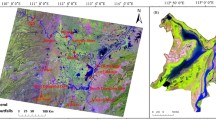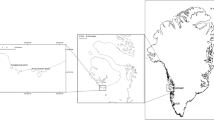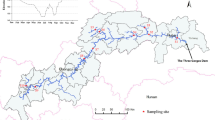Abstract
Carex meadows are critical habitat for wintering geese in the floodplains of the middle and lower reaches of Yangtze River, China. These meadows follow a growth cycle closely tied to the seasonal hydrological fluctuation: as water levels recede in the fall, exposed mudflats provide habitat for Carex spp. growth. The seasonal growth of Carex overlaps the arrival of wintering geese and provides an important food source for the migrants. Recent alterations to the Yangtze’s hydrology, however, have disrupted the synchronous relationship between water levels, Carex growth and wintering geese at Dongting Lake. In October 2012, we carried out an outdoor mesocosm experiment to investigate potential impacts of delayed water recession on the germination and growth of Carex heterolepis, the dominant Carex species at Dongting Lake, to understand how changes in hydrology might impact wintering goose habitat. Results showed that the delayed flood recession exerted significant impact on the first growth cycle of Carex growth. Prolonged inundation significantly lowered the intrinsic growth rate (P = 0.03) and maximum growth rates (P = 0.02). It also took significantly longer time to reach the peak growth rate (P = 0.04 and 0.05 for number of shoot and biomass, respectively). As a result, biomass accumulation was reduced by 45, 62 and 90 % for 10-day, 20-day and 30-day inundation treatments, respectively. These results indicate a severe risk of food shortage for wintering geese when water recession delayed. This potential risk should be taken into consideration when operating any hydrological control structures that alter the flood regimes in Dongting Lake.






Similar content being viewed by others
References
Acreman MC, Ferguson AJD (2010) Environmental flows and the European Water Framework Directive. Freshw Biol 55(1):32–48
Auld TD, Denham AJ (2006) How much seed remains in the soil after a fire? Plant Ecol 187:15–24
Barter M, Chen L, Cao L, Lei G (2004) Waterbird survey of the middle and lower Yangtze River floodplain in late January and early February 2004. China Forestry Publishing House Company, Beijing
Berga L, Buil J, Bofill E, De Cea JC, Garcia Perez JA, Mañueco G, Polimon J, Soriano A, Yagüe J (2006) Dams and Reservoirs, Societies and Environment in the 21st Century Proceeding of the International Symposium on Dams in the Societies of the 21st Century, 22nd International Congress on Large Dams (ICOLD). Taylor & Francis, Barcelona, Spain
Blom CWPM (1999) Adaptations to flooding stress: from plant community to molecule. Plant Biol 1(3):261–273
Blom CWPM, Voesenek LACJ (1996) Flooding: the survival strategies of plants. Trends Ecol Evol 11(7):290–295
Bonis A, Lepart J (1994) Vertical structure of seed banks and the impact of depth of burial on recruitment in two temporary marshes. Vegetatio 112(2):127–139
Bunn SE, Arthington AH (2002) Basic principles and ecological consequences of altered flow regimes for aquatic biodiversity. Environ Manage 30(4):492–507
Cao L, Barter M, Lei G (2008) New Anatidae population estimates for eastern China: implications for current flyway estimates. Biol Conserv 141(9):2301–2309
Chao BF, Wu YH, Li YS (2008) Impact of artificial reservoir water impoundment on global sea level. Science 320(5873):212–214
China Council for International Cooperation on Environment and Development (2010) Ecosystem services and management strategy in China: study report for AGM, Beijing
Cong PH, Wang X, Cao L, Fox AD (2012) Within-winter shifts in Lesser White-fronted Goose Anser erythropus distribution at East Dongting Lake, China. Ardea 100(1):5–11
Dudgeon D, Angela HA, Mark OG, Zen-Ichiro K, Duncan JK, Christian L, Robert JN, Anne-Hélène PR, Doris S, Melanie LJS, Caroline AS (2006) Freshwater biodiversity: importance, threats, status and conservation challenges. Biol Conserv 81(2):163–182
Ehrlich PR, Ehrlich AH (1992) The value of biodiversity. Ambio 21(3):219–226
Fang JY, Wang ZH, Zhao SQ, Li YK, Tang ZY, Yu D, Ni LY, Liu HZ, Xie P, Da LJ, Li ZQ, Zheng CY (2006) Biodiversity changes in the lakes of the Central Yangtze. Front Ecol Environ 4(7):369–377
Finlayson M, Harris J, McCartney M, Lew Y, Zhang C (2010) Report on Ramsar visit to Poyang Lake Ramsar Site, P.R. China. Ramsar Convention. http://www.ramsar.org/pdf/Poyang_lake_report_v8.pdf. Accessed 28 Mar 2014
Fox AD, Cao L, Barter M, Rees EC, Hearn RD, Cong PH, Wang X, Zhang Y, Dou ST, Shao XF (2008) The functional use of East Dongting Lake, China, by wintering geese. Wildfowl 58:3–19
Fu CZ, Wu JH, Chen JK, Wu QH, Lei GC (2003) Freshwater fish biodiversity in the Yangtze River basin of China: patterns, threats and conservation. Biodivers Conserv 12(8):1649–1685
Greet J, Cousens RD, Webb JA (2013) Seasonal timing of inundation affects riparian plant growth and flowering: implications for riparian vegetation composition. Plant Ecol 214(1):87–101
Guo H, Hu Q, Zhang Q, Feng S (2012) Effects of the Three Gorges Dam on Yangtze River flow and river interaction with Poyang Lake, China: 2003–2008. J Hydrol 416:19–27
Hanasaki N, Kanae S, Oki T (2006) A reservoir operation scheme for global river routing models. J Hydrol 327(1):22–41
Kahm M, Hasenbrink G, Lichtenberg-Fraté H, Ludwig J, Kschischo M (2010) Grofit: fitting biological growth curves with R. J Stat Softw 33(7):1–21
Lei G (2000) Status of the Lesser White-fronted Goose in China. In: Tolvanen P, Øien IJ, Ruokolainen K (eds.) Fennoscandian Lesser White-fronted Goose Conservation Project-Annual report 1999, pp 16–17
Li FS, Wu JD, James J, James B (2012) Number and distribution of cranes wintering at Poyang Lake, China during 2011–2012. Chin Bird 3(3):180–190
Liu J (2011) Diet and activities of wintering Tundra Bean Geese Anser fabalis serrirostris at Shengjin Lake, NNR, Anhui Province. Dissertation, University of Science and Technology of China
Liu XK (2013) Information Sheet on Ramsar Wetlands (RIS)—2009–2014 version. Wetlands International http://ramsar.wetlands.org/Database/SearchforRamsarsites/tabid/765/Default.aspx. Accessed 8 Mar 2014
Liu GH, Wei L, Jin Z, Liu WZ, Yang D, Davy AJ (2006) How does the propagule bank contribute to cyclic vegetation change in a lakeshore marsh with seasonal drawdown? Aquat Bot 84(2):137–143
MEA (2005) Ecosystems and human well being-synthesis. Island Press, Washington
Nilsson C, Reidy CA, Dynesius M, Revenga C (2005) Fragmentation and flow regulation of the world’s large river systems. Science 308(5720):405–408
Owens NW (1997) Responses of wintering brent geese to human disturbance. Wildfowl 28(28):5–14
Qiu J (2011) China admits problems with Three Gorges Dam. Nature. doi:10.1038/news.2011.315
R Development Core Team (2012) R: a language and environment for statistical computing. R Foundation for Statistical Computing, Vienna. http://www.R-project.org/. Accessed 28 Sept 2012
Ramsar Convention (2013) Wetlands and agriculture: partners for growth. Ramsar Convention. http://www.ramsar.org/cda/en/ramsar-home/main/ramsar/1_4000_0__. Accessed 28 Mar 2014
Stone R (2008) Beijing’s Marathon run to clean foul air nears finish line. Science 321(6044):636–637
Stone R (2011) The legacy of the Three Gorges Dam. Science 333(5889):817
Sun ZD, Huang Q, Opp C, Hennig T, Marold U (2012) Impacts and Implications of major changes caused by the Three Gorges Dam in the middle reaches of the Yangtze River, China. Water Resour Manag 26(12):3367–3378
Thompson K, Bakker JP, Bekker RM (1997) The soil seed banks of North West Europe: methodology, density and longevity. Cambridge University Press, Cambridge
Tockner K, Ward JV, Stanford JA (2002) Riverine flood plains: present state and future trends. Environ Conserv 29(3):308–330
Tockner K, Bunn SE, Gordon C, Naiman RJ, Quinn GP, Standord JA (2008) Flood plains: critically threatened ecosystems. In: Polunin NVC (ed) Aquatic ecosystems: trends and global prospects. Cambridge University Press, Cambridge, pp 45–61
Underwood AJ (1997) Experiments in ecology: their logical design and interpretation using analysis of variance. Cambridge University Press, Cambridge
Verhoeven JT, Setter TL (2010) Agricultural use of wetlands: opportunities and limitations. Ann Bot 105(1):155–163
Vickery JA, Gill JA (1999) Managing grassland for wild geese in Britain: a review. Biol Conserv 89(1):93–106
Vörösmarty CJ, Meybeck M, Fekete B, Sharma K, Green P, Syvitski JPM (2003) Anthropogenic sediment retention: major global impact from registered river impoundments. Glob Planet Change 39(1):169–190
Wang X, Fox AD, Cong PH, Barter M, Cao L (2012) Changes in the distribution and abundance of wintering Lesser White-fronted Geese Anser erythropus in eastern China. Bird Conserv Int 22(2):128–134
Wang YY, Jia YF, Guan L, Lei GC, Wen L, Lui GX (2013) Optimising hydrological conditions to sustain wintering waterbird populations in Poyang Lake National Natural Reserve: implications for dam operations. Freshw Biol 58:2366–2379
Wood S (2010) mgcv: Mixed GAM Computation Vehicle with GCV/AIC/REML smoothness estimation. http://opus.bath.ac.uk/32507/
Wu YH, Ji WT (2002) Study on Jiangxi Poyang Lake National Natural Reserve. China Forestry Publishing House Company, Beijing
Yang XL (2011) Research on the numbers, distribution, feeding behavior and diet of Great White Fronted Geese at Shengjin Lake, the national natural reserves in Anhui Province. Dissertation, University of Science and Technology of China
Yuan ZK (2008) Resource and environment of Dongting Lake wetland. Hunan Normal University Publishing House Company, Hunan
Zhao SQ, Fang JY, Miao SL, Gu B, Tao S, Peng CH, Tang ZY (2005) The 7-decade degradation of a large freshwater lake in Central Yangtze River, China. Environ Sci Technol 39(2):431–436
Zhao MJ, Cao L, Fox AD (2010) Changes in within-winter distribution and diet of wintering Tundra Bean Geese Anser fabalis serrirostris at Shengjin Lake, Yangtze floodplain, China. Wildfowl 60:52–63
Zhao MJ, Cong PH, Barter M, Fox AD, Cao L (2012) The changing abundance and distribution of Greater White-fronted Geese Anser albifrons in the Yangtze River floodplain: impacts of recent hydrological changes. Bird Conserv Int 22(2):135–143
Acknowledgments
We thank EDTLNNR and Dongting Lake Station for Wetland Ecosystem Research, Chinese Academy of Science for providing experimental station and instruments. We are also grateful to Mr. Xiangcai Zhang a local resident, for providing help with plant sample management. We thank Dr. Peihao Cong (Lanzhou University), Dr. Zhiyong Hou (Dongting Lake Station for Wetland Ecosystem Research, Chinese Academy of Science), Dr. Bolong Wen (Northeast Institute of Geography and Agroecology, Chinese Academy of Sciences), and Yu Ning, a PhD candidate at Beijing Forestry University for their help during the identification of Carex species. We thank James Burnham (a PhD candidate at University of Wisconsin-Madison) and Xiaoxue Yang (Beijing Forestry University) for correcting English expression, grammar, syntax and spelling, as well as providing us with constructive comments to improve our manuscript. We are grateful to the journal editors, Dr. Neil Saintilan (Science Division, Office of Environment and Heritage, NSW Australia), Dr. John Takekawa (USGS Western Ecological Research Center, SFB Estuary Field Station, 505 Azuar Drive, Vallejo, USA), and one anonymous reviewer for their insightful suggestions and comments. The study was supported by the National Basic Research Program of China (973 Program, Grant No. 2012CB417005 & No. 2009CB421103).
Author information
Authors and Affiliations
Corresponding author
Rights and permissions
About this article
Cite this article
Guan, L., Wen, L., Feng, D. et al. Delayed Flood Recession in Central Yangtze Floodplains Can Cause Significant Food Shortages for Wintering Geese: Results of Inundation Experiment. Environmental Management 54, 1331–1341 (2014). https://doi.org/10.1007/s00267-014-0350-7
Received:
Accepted:
Published:
Issue Date:
DOI: https://doi.org/10.1007/s00267-014-0350-7




